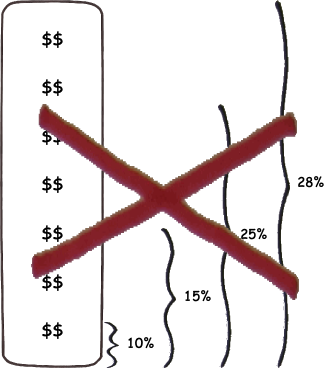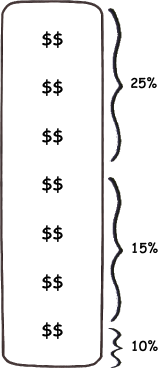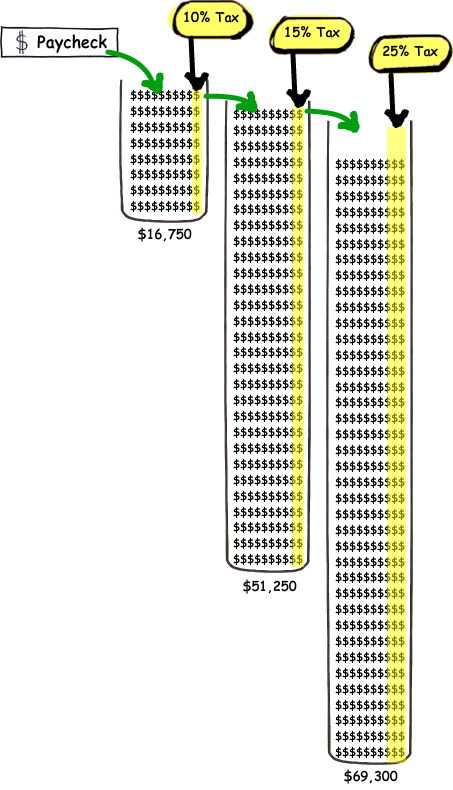A Quick Look at Tax Brackets (Dull, I know, but Bear With Me!)
Most of you probably know how these things work already, but I’ve heard it described poorly in the news so many times recently that I feel compelled to bring it up…just in case.
When someone talks about tax brackets, what they’re really referring to are marginal tax rates. That word “marginal” in economic terms means something like “one more”. For example, the cost of making donuts might be $10,000 for all the equipment. But once I’ve spent all that, I can make a single donut for the marginal cost of $0.10—just a bit of ingredients, heat, and labor. Once my costs are covered, every cent I sell donuts for over $0.10 is profit (simplifying a bit here, cut me some slack).
In the tax world, marginal refers to additional dollars earned. So the marginal tax rate affects dollars earned past a specific threshold. Hmmm, that’s not helping. Here’s an illustration of what a tax bracket is not:

This shows that when you move into the next bracket that all of your income is taxed at a higher rate. That’s not true. It’s only the income that is inside the new bracket that is taxed, like this:

That is, a tiny slice is taxed at 10%, a larger slice is taxed at 15%, and a final slice is taxed at 25%. Let’s try a new way to visualize this. Imagine your money as water filling up cups from left to right, until it runs out (insert liquidity joke and click here; good job):

I’ve attempted to draw this somewhat to scale—notice that the brackets (cups) are not of equal size. What this means is that your first $16,750 of income fills up the first cup and is reduced by 10% in taxes. Your next cup fills up with $51,250 additional income and you part with 15% of it. Assuming you’re doing quite well, your next $69,300 of additional income is taxed at 25%. In my illustration the third cup isn’t quite full so the next few bucks you make will be taxed at 25%, eventually entering the 28% bracket (not shown) once you cross $137,300 in total income.
One key thing this picture illustrates is that even if someone makes a billion dollars, their first three cups look pretty much the same as above (all full, of course). This means that if a tax break is applied to just the lower brackets, *the billionaire will get the exact same tax break *as the much less prosperous (but exceedingly comfortable) person depicted above.
More directly, if congress were to lower the tax rate of the first cup, it would be a tax cut for 100% of taxpayers. However, if they cut the rate only for say, cup 4, only those making more than $137,300 would benefit.
These rates, and the points at which they kick in change occasionally and that’s usually what the politicians are arguing about.
If you just can’t contain yourself, check out this nice calculator/reference table or this How Stuff Works article which does a nice job on the topic.
Did that help? Did I make it worse? Let me know!
